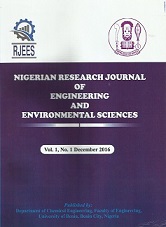Extraction and Characterization of Essential Oil and Oleoresin from Ginger Rhizome using Near-Critical Condition in a Modified Autoclave
Authors: Mohammed, S.A., Isah, A.G, Kovo, A.S. And Olutoye, M.A.
DOI Info: http://doi.org/10.5281/zenodo.12599825
ABSTRACT
Ginger (Zingiber officinale Roscoe) is an important and widely used spice for both culinary and medicinal purposes for more than 3500 years. The study is aimed at extraction and analysis of the essential oil from fresh and dried ginger rhizome. The oils were obtained by near-critical conditions in a modified high-pressure fluid extraction unit using liquid carbon dioxide and analysed using Fourier Transform Infrared Spectroscopy (FT-IR), Gas Chromatography Mass Spectrometry (GC-MS) and High-Performance Liquid Chromatography (HPLC). A maximum of 2.3% was obtained from the dried ginger while the fresh ginger contained 1.0% indicating that the dried ginger yields more oil than the fresh ginger. The following compounds: hydroxyl, alkanes, carboxylic acid, carbonate-carboxylic, amines, aldehydes, alcohol and carbonyl functional groups were revealed in the FT-IR analysis. Analysis of GC-MS and HPLC-MS identified seven and eight components, respectively. The major qualitative and quantitative constituents in the fresh and dried extracts of the Nigerian ginger essential oil using liquid carbon dioxide for extractions are gingerol (21.36%, 20.36%), followed by zingerone (10.86%, 10.86%), zingiberene (10.12%, 10.12%), shogaol (6.15%, 4.83%), paradol (6.11%, 6.42%), a-farnesene (3.26%, 4.97%) and piperine (4.01%, 4.01%) using GC-MS. While HPLC-MS analysis gives shogaol (24.65%, 25.96%), followed by gingerol (18.52%, 20.04%), 8-gingerol (8.31%, 14.01%), paradol (11.58%, 10.48%), vanillic acid (6.95%, 3.03%), (10)-shogaol (5.47%, 6.86%), zingerone (5.74%, 3.72%) and [8]-dehydrogingerdione (5.72%, 4.16%). In conclusion, it therefore shows that the dry ginger gives higher yield than the fresh ginger likewise bioactive compounds were identified and quantified in the fresh and dried gingers.
Affiliations: Department of Chemical Engineering, School of Infrastructure, Process Engineering and Technology, Federal University of Technology, PMB 65 Minna, Nigeria.
Keywords: Ginger, High Pressure Fluid Extraction Unit, Ginger Essential Oil, Near-critical Liquid Carbon Dioxide, Active Constituents
Published date: 2024/06/30









